Cardiac Rhythm Management Devices Market Size
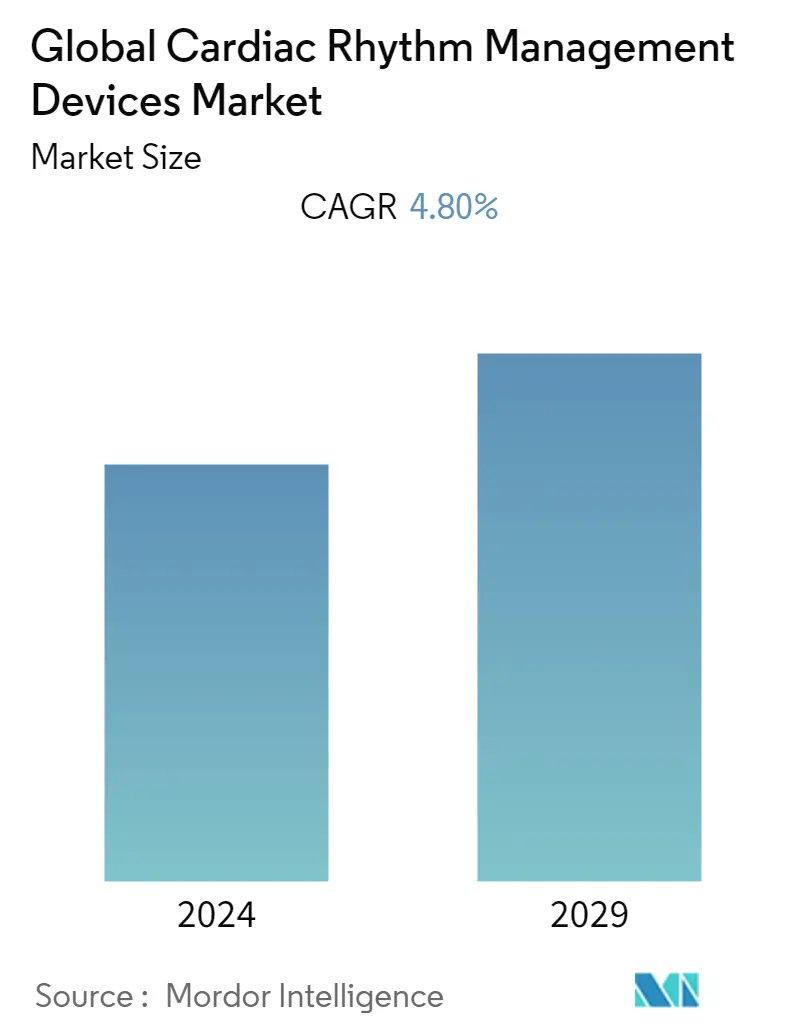
| Study Period | 2019 - 2029 |
| Base Year For Estimation | 2023 |
| Forecast Data Period | 2024 - 2029 |
| CAGR | 4.80 % |
| Fastest Growing Market | Asia Pacific |
| Largest Market | North America |
Major Players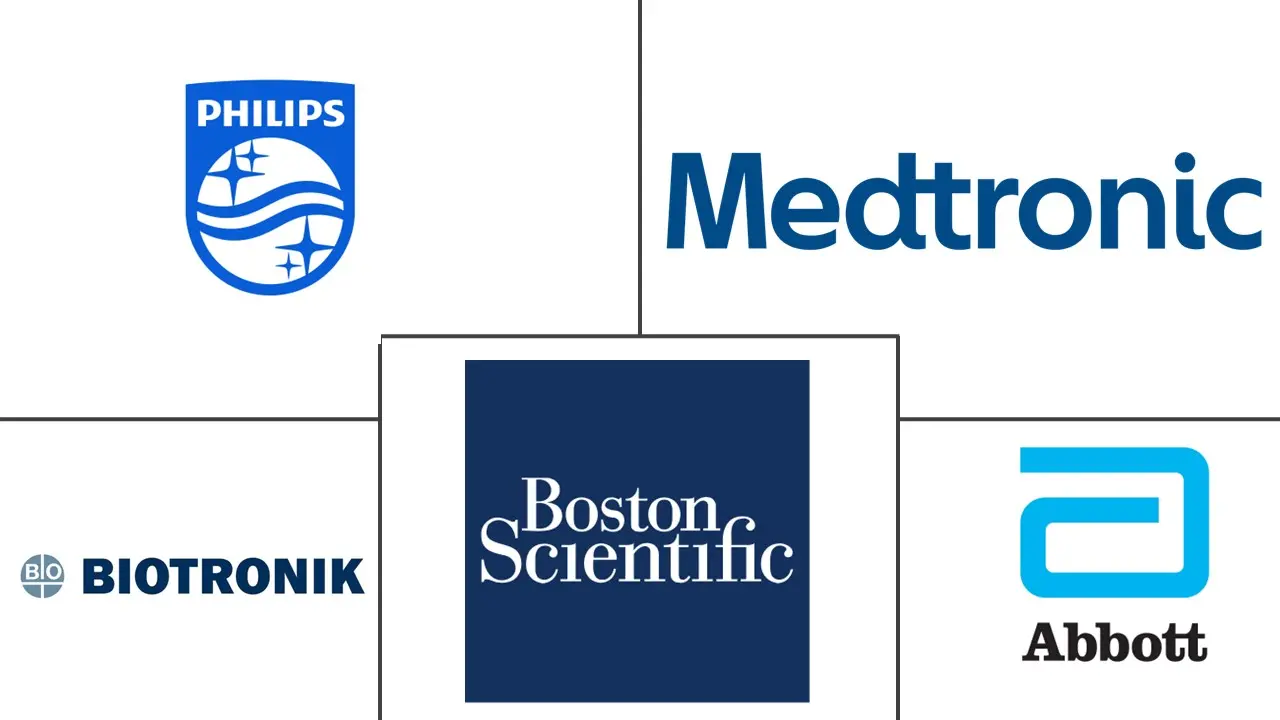
*Disclaimer: Major Players sorted in no particular order |
Cardiac Rhythm Management Devices Market Analysis
The cardiac rhythm management devices market is expected to witness a CAGR of 4.8% during the forecast period.
The COVID-19 pandemic led to disruption in the medical devices industry around the world which also impacted the cardiac rhythm management devices market. According to a research article by Tarun Dalia et al., published in the Indian Heart Journal in February 2021, the presence of congestive heart failure (CHF) in patients with COVID-19 is associated with increased mortality and worse outcomes. Moreover, there is an increased risk of acute cardiac injury and cardiac arrhythmia among non-survivors and severe COVID-19 patients. Therefore, the COVID-19 pandemic has been reported to cause worse outcomes in patients with underlying cardiovascular disease, especially in patients with acute cardiac injury. Therefore, the market in 2020 has been impacted by the growing COVID-19 patient pool and the rising likelihood of significantly increased risks for susceptible patients with cardiovascular disorders.
Certain factors that are driving the market growth include the increasing prevalence of cardiovascular disorders, technological advancements, a rise in the use of ambulatory and home services for cardiac monitoring, and favorable reimbursement policies. An increasing patient pool of cardiovascular diseases (CVDs) is one of the prime factors augmenting the growth of the cardiac rhythm management devices market. Sedentary lifestyles, junk food consumption, and mental stress are other key factors associated with the development of CVDs. According to the World Health Organization (WHO) data updated in June 202, cardiovascular diseases account for more than 30% of deaths worldwide. Also, nearly 33.5 million people are suffering from atrial fibrillation (AFib) globally, which is the most common type of serious arrhythmia. With the rise in the aging population in North America and Europe, the number of patients suffering from heart rhythm disorders is likely to witness an increase over the forecast period. In turn, it is expected to aid the overall market growth during the forecast period.
However, the therapeutic radiation used in cancer treatment can influence the operation of a patient with implantable cardiac rhythm devices. The implantable device technology uses complementary metal-oxide-semiconductor (CMOS) which are vulnerable to damage by the therapeutic doses of radiation, but it can vary according to the type of device in use. This factor is one of the major factors that limits the scope of using cardiac rhythm management devices, as the implants are highly sensitive and their malfunctioning may have serious consequences. On the other hand, the high cost of these devices with limited insurance coverage is limiting the growth of the market.
Cardiac Rhythm Management Devices Market Trends
This section covers the major market trends shaping the Cardiac Rhythm Management Devices Market according to our research experts:
Defibrillator is Expected to Hold the Largest Market Share in the Product Type
A defibrillator is a medical device that restores a normal heartbeat by sending an electric pulse or shock to the heart. This device is used to treat cardiac conditions such as arrhythmia, a heartbeat that is uneven or that is too slow or too fast. The use of defibrillators is increasing due to their efficacy in treating cardiac arrest. For instance, according to the Heart and Stroke Statistics - 2022 Update published by the American Heart Association, cardiac arrest is still a public health issue owing to the high number of out-of-hospital cardiac arrests (OHCA i.e. 356,000 times every year in the United States, with over 90% of them being fatal. Non-traumatic OHCA as determined by the emergency medical system (EMS) is estimated to affect 356,461 people each year, or over 1,000 people per day. After EMS-treated cardiac arrest, the chance of surviving hospital discharge is around 10%. This indicates that the usage of defibrillators has experienced a significant rise, globally, over the forecast period.
Several market players are engaged in the implementation of strategic initiatives, thereby contributing to segment growth. For instance, in October 2020, Abbott launched its new implantable cardioverter-defibrillator (ICD) and cardiac resynchronization therapy defibrillator (CRT-D) devices in India. Through smartphone connectivity and associated applications, the devices provide new potential for patient interaction and remote monitoring. Other advantages include a patient-friendly design, longer battery life, and MRI compatibility.
As a result, all of the aforementioned reasons are likely to contribute to this segment's strong growth over the forecast period.
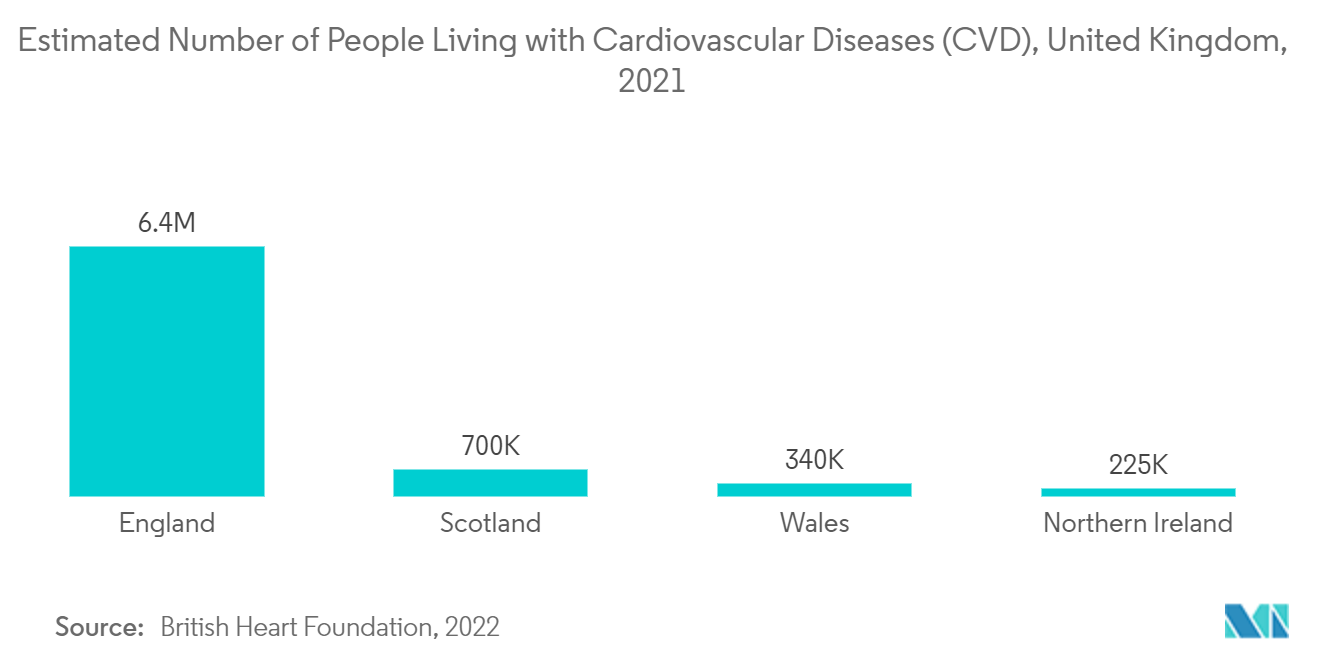
North America Dominates the Market and is Expected to do Same in the Forecast Period
North America is expected to have the largest market share for cardiac rhythm management, due to the developed healthcare infrastructure, government initiatives, and rising burden of cardiovascular diseases demanding more cardiac implants. According to the American Heart Association data updated in January 2021, by 2035, around 45% of the United States population is likely to suffer from heart disease, due to factors like high obesity, high smoking, and unhealthy lifestyles, which may lead to heart attacks and other related issues. In addition to this, according to the Centers for Disease Control and Prevention (CDC), COVID-19 patients with an underlying heart condition are still more likely to become severely ill. Additionally, according to the American College of Cardiology (ACC), on March 6, 2020, people who have an underlying cardiovascular disease have a higher mortality rate when it comes to COVID-19 (10.5%) than people who have an underlying chronic respiratory disease (6.3%). Thus, North America is expected to dominate the cardiac rhythm management market over the forecast period.
Several companies are starting various strategies like collaborations, new product launches, and mergers and acquisitions to maintain and increase their market shares. For instance, in June 2021, AliveCor announced that the company has acquired the independent diagnostic testing facility (IDTF) CardioLabs, a leading monitoring, and cardiac diagnostic service provider. The acquisition is a cornerstone of AliveCor's mission to extend its comprehensive cardiological services to patients who are prescribed monitoring devices by their healthcare providers. Moreover, in July 2021, Abbott launched Jot Dx, the latest insertable cardiac monitor (ICM). The technology allows for remote detection and improved diagnostic accuracy of cardiac arrhythmia in patients. Thus, due to the above-mentioned developments, the market is expected to grow during the forecast period.
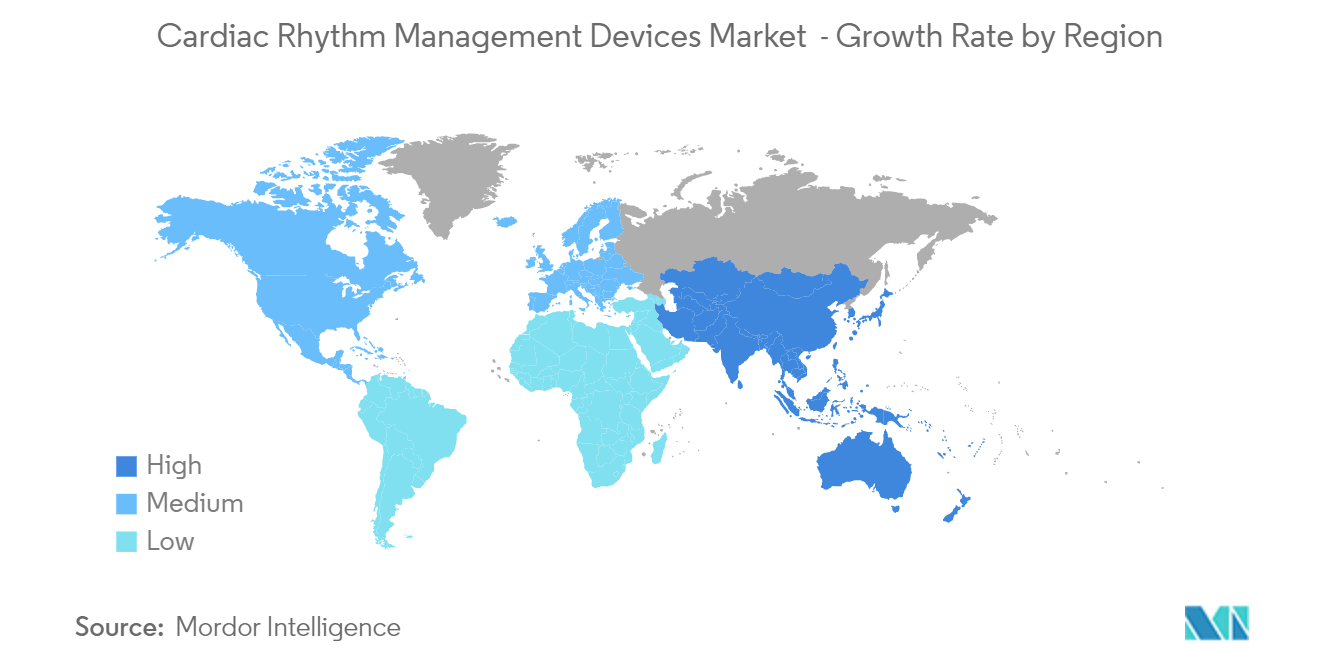
Cardiac Rhythm Management Devices Industry Overview
The cardiac rhythm management devices market is highly competitive and consists of a few major players. Companies like Abbott, Abiomed, Biotronik SE & Co KG, Boston Scientific Corporation, Koninklijke Philips NV, LivaNova Plc, Medtronic PPLC, SchillerAG, Shenzhen Mindray Biomedical Electronics Co. Ltd, Physio-Control, Inc. (Stryker), LivaNova Plc, Progetti Srl, and Zoll Medical Corporation, among others, hold the substantial market share in the cardiac rhythm management devices market.
Cardiac Rhythm Management Devices Market Leaders
-
Abbott
-
Biotronik SE & Co KG
-
Boston Scientific Corporation
-
Medtronic PLC
-
Koninklijke Philips NV
*Disclaimer: Major Players sorted in no particular order
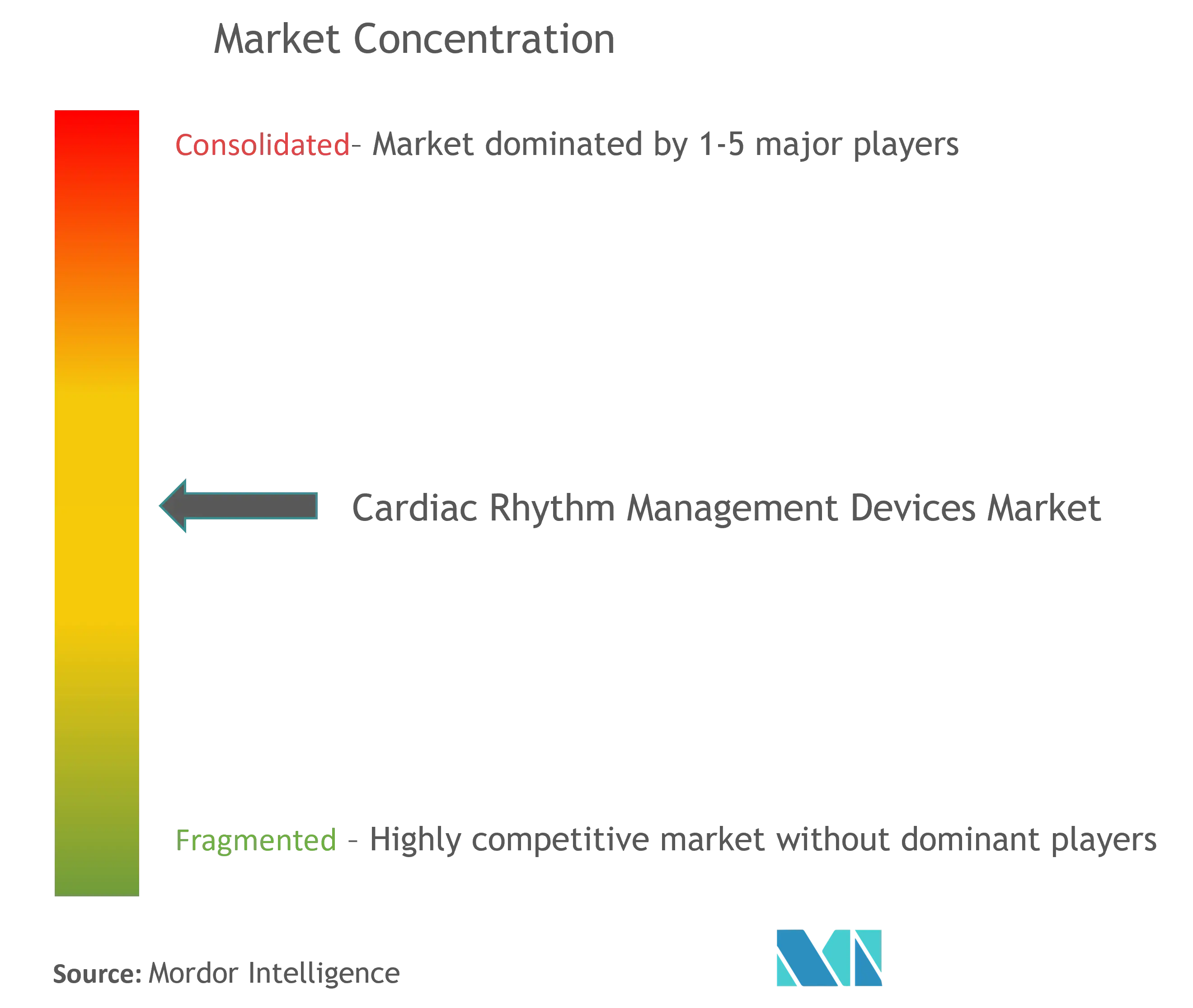
Cardiac Rhythm Management Devices Market News
- In April 2022, Abbott announced that the United States Food and Drug Administration (FDA) has approved the Aveir single-chamber (VR) leadless pacemaker for the treatment of patients in the United States with slow heart rhythms. This represents a huge improvement in patient care and offers patients and their doctors brand-new, never-before-seen features.
- In January 2022, Medtronic plc announced it has received approval from Japan's Ministry of Health, Labor and Welfare for the sale and reimbursement of the Micra AV Transcatheter Pacing System (TPS).
Cardiac Rhythm Management Devices Market Report - Table of Contents
1. INTRODUCTION
- 1.1 Study Assumptions and Market Definition
- 1.2 Scope of the Study
2. RESEARCH METHODOLOGY
3. EXECUTIVE SUMMARY
4. MARKET DYNAMICS
- 4.1 Market Overview
-
4.2 Market Drivers
- 4.2.1 Increasing Prevalence of Cardiovascular Disorders
- 4.2.2 Technological Advancements
- 4.2.3 Rise in the Use of Ambulatory and Home Services for Cardiac Monitoring
-
4.3 Market Restraints
- 4.3.1 Effects of Therapeutic Radiation on Implantable Cardiac Rhythm Devices
- 4.3.2 High Cost of Devices
-
4.4 Porter's Five Forces Analysis
- 4.4.1 Threat of New Entrants
- 4.4.2 Bargaining Power of Buyers/Consumers
- 4.4.3 Bargaining Power of Suppliers
- 4.4.4 Threat of Substitute Products
- 4.4.5 Intensity of Competitive Rivalry
5. MARKET SEGMENTATION (Market Size by Value - USD million)
-
5.1 By Product
- 5.1.1 Defibrillators
- 5.1.1.1 Implantable Cardioverter Defibrillators (ICDS)
- 5.1.1.2 External Defibrillators (ED)
- 5.1.2 Pacemakers
- 5.1.2.1 Implantable Pacemakers (ICPS)
- 5.1.2.2 External Pacemakers
- 5.1.3 Cardiac Resynchronization Therapy Devices
- 5.1.3.1 Cardiac Resynchronization Therapy Defibrillators (CRT-D)
- 5.1.3.2 Cardiac Resynchronization Therapy Pacemakers (CRT-P)
-
5.2 Geography
- 5.2.1 North America
- 5.2.1.1 United States
- 5.2.1.2 Canada
- 5.2.1.3 Mexico
- 5.2.2 Europe
- 5.2.2.1 Germany
- 5.2.2.2 United Kingdom
- 5.2.2.3 France
- 5.2.2.4 Italy
- 5.2.2.5 Spain
- 5.2.2.6 Rest of Europe
- 5.2.3 Asia-Pacific
- 5.2.3.1 China
- 5.2.3.2 Japan
- 5.2.3.3 India
- 5.2.3.4 Australia
- 5.2.3.5 South Korea
- 5.2.3.6 Rest of Asia-Pacific
- 5.2.4 Middle East and Africa
- 5.2.4.1 GCC
- 5.2.4.2 South Africa
- 5.2.4.3 Rest of Middle East and Africa
- 5.2.5 South America
- 5.2.5.1 Brazil
- 5.2.5.2 Argentina
- 5.2.5.3 Rest of South America
6. COMPETITIVE LANDSCAPE
-
6.1 Company Profiles
- 6.1.1 Abbott Laboratories
- 6.1.2 Abiomed
- 6.1.3 Biotronik SE & Co KG
- 6.1.4 Boston Scientific Corporation
- 6.1.5 Koninklijke Philips NV
- 6.1.6 LivaNova Plc
- 6.1.7 Medtronic PLC
- 6.1.8 SchillerAG
- 6.1.9 Shenzhen Mindray Biomedical Electronics Co., Ltd
- 6.1.10 Zoll Medical Corporation
- 6.1.11 Physio-Control, Inc. (Stryker)
- 6.1.12 LivaNova Plc
- 6.1.13 Progetti Srl
- *List Not Exhaustive
7. MARKET OPPORTUNITIES AND FUTURE TRENDS
** Subject To AvailablityCardiac Rhythm Management Devices Industry Segmentation
Cardiac rhythm management is a part of electrophysiology, which is used to manage the functioning of the heart. The last decade has observed an ongoing evolution and the use of cardiac rhythm management devices, including cardiac resynchronization therapy, pacemakers, implantable cardioverter defibrillators, and loop recorders. General practitioners (GP) are increasingly involved in the follow-up and management of patients with these devices. The Cardiac Rhythm Management Devices market is segmented by Product (Defibrillators (Implantable Cardioverter Defibrillators (ICDS) and External Defibrillators (ED)), Pacemakers (Implantable Pacemakers (ICPS) and External Pacemakers), and Cardiac Resynchronization Therapy Devices (Cardiac Resynchronization Therapy Defibrillators (CRT-D) and Cardiac Resynchronization Therapy Pacemakers (CRT-P))), and Geography (North America, Europe, Asia-Pacific, Middle East and Africa, and South America). The market report also covers the estimated market sizes and trends for 17 different countries across major regions, globally. The report offers the value (in USD million) for the above segments.
| By Product | Defibrillators | Implantable Cardioverter Defibrillators (ICDS) |
| External Defibrillators (ED) | ||
| By Product | Pacemakers | Implantable Pacemakers (ICPS) |
| External Pacemakers | ||
| By Product | Cardiac Resynchronization Therapy Devices | Cardiac Resynchronization Therapy Defibrillators (CRT-D) |
| Cardiac Resynchronization Therapy Pacemakers (CRT-P) | ||
| Geography | North America | United States |
| Canada | ||
| Mexico | ||
| Geography | Europe | Germany |
| United Kingdom | ||
| France | ||
| Italy | ||
| Spain | ||
| Rest of Europe | ||
| Geography | Asia-Pacific | China |
| Japan | ||
| India | ||
| Australia | ||
| South Korea | ||
| Rest of Asia-Pacific | ||
| Geography | Middle East and Africa | GCC |
| South Africa | ||
| Rest of Middle East and Africa | ||
| Geography | South America | Brazil |
| Argentina | ||
| Rest of South America |
Cardiac Rhythm Management Devices Market Research FAQs
What is the current Global Cardiac Rhythm Management Devices Market size?
The Global Cardiac Rhythm Management Devices Market is projected to register a CAGR of 4.80% during the forecast period (2024-2029)
Who are the key players in Global Cardiac Rhythm Management Devices Market?
Abbott, Biotronik SE & Co KG, Boston Scientific Corporation, Medtronic PLC and Koninklijke Philips NV are the major companies operating in the Global Cardiac Rhythm Management Devices Market.
Which is the fastest growing region in Global Cardiac Rhythm Management Devices Market?
Asia Pacific is estimated to grow at the highest CAGR over the forecast period (2024-2029).
Which region has the biggest share in Global Cardiac Rhythm Management Devices Market?
In 2024, the North America accounts for the largest market share in Global Cardiac Rhythm Management Devices Market.
What years does this Global Cardiac Rhythm Management Devices Market cover?
The report covers the Global Cardiac Rhythm Management Devices Market historical market size for years: 2019, 2020, 2021, 2022 and 2023. The report also forecasts the Global Cardiac Rhythm Management Devices Market size for years: 2024, 2025, 2026, 2027, 2028 and 2029.
Cardiac Rhythm Management Devices Industry Report
Statistics for the 2024 Cardiac Rhythm Management Devices market share, size and revenue growth rate, created by Mordor Intelligence™ Industry Reports. Cardiac Rhythm Management Devices analysis includes a market forecast outlook to 2029 and historical overview. Get a sample of this industry analysis as a free report PDF download.



